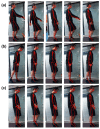Computer Vision and Machine Learning-Based Gait Pattern Recognition for Flat Fall Prediction
- PMID: 36298311
- PMCID: PMC9612353
- DOI: 10.3390/s22207960
Computer Vision and Machine Learning-Based Gait Pattern Recognition for Flat Fall Prediction
Abstract
Background: Gait recognition has been applied in the prediction of the probability of elderly flat ground fall, functional evaluation during rehabilitation, and the training of patients with lower extremity motor dysfunction. Gait distinguishing between seemingly similar kinematic patterns associated with different pathological entities is a challenge for the clinician. How to realize automatic identification and judgment of abnormal gait is a significant challenge in clinical practice. The long-term goal of our study is to develop a gait recognition computer vision system using artificial intelligence (AI) and machine learning (ML) computing. This study aims to find an optimal ML algorithm using computer vision techniques and measure variables from lower limbs to classify gait patterns in healthy people. The purpose of this study is to determine the feasibility of computer vision and machine learning (ML) computing in discriminating different gait patterns associated with flat-ground falls.
Methods: We used the Kinect® Motion system to capture the spatiotemporal gait data from seven healthy subjects in three walking trials, including normal gait, pelvic-obliquity-gait, and knee-hyperextension-gait walking. Four different classification methods including convolutional neural network (CNN), support vector machine (SVM), K-nearest neighbors (KNN), and long short-term memory (LSTM) neural networks were used to automatically classify three gait patterns. Overall, 750 sets of data were collected, and the dataset was divided into 80% for algorithm training and 20% for evaluation.
Results: The SVM and KNN had a higher accuracy than CNN and LSTM. The SVM (94.9 ± 3.36%) had the highest accuracy in the classification of gait patterns, followed by KNN (94.0 ± 4.22%). The accuracy of CNN was 87.6 ± 7.50% and that of LSTM 83.6 ± 5.35%.
Conclusions: This study revealed that the proposed AI machine learning (ML) techniques can be used to design gait biometric systems and machine vision for gait pattern recognition. Potentially, this method can be used to remotely evaluate elderly patients and help clinicians make decisions regarding disposition, follow-up, and treatment.
Keywords: convolutional neural network; fall recognition; gait; k nearest neighbor; long short-time memory; machine learning; pattern recognition; support vector machine.
Conflict of interest statement
The authors declare no conflict of interest.
Figures











Similar articles
-
Evaluation of Three Machine Learning Algorithms for the Automatic Classification of EMG Patterns in Gait Disorders.Front Neurol. 2021 May 21;12:666458. doi: 10.3389/fneur.2021.666458. eCollection 2021. Front Neurol. 2021. PMID: 34093413 Free PMC article.
-
Automated classification of neurological disorders of gait using spatio-temporal gait parameters.J Electromyogr Kinesiol. 2015 Apr;25(2):413-22. doi: 10.1016/j.jelekin.2015.01.004. Epub 2015 Feb 7. J Electromyogr Kinesiol. 2015. PMID: 25725811
-
Artificial Intelligence Algorithm-Based Economic Denial of Sustainability Attack Detection Systems: Cloud Computing Environments.Sensors (Basel). 2022 Jun 21;22(13):4685. doi: 10.3390/s22134685. Sensors (Basel). 2022. PMID: 35808184 Free PMC article.
-
Machine Learning Methods for Small Data Challenges in Molecular Science.Chem Rev. 2023 Jul 12;123(13):8736-8780. doi: 10.1021/acs.chemrev.3c00189. Epub 2023 Jun 29. Chem Rev. 2023. PMID: 37384816 Free PMC article. Review.
-
Artificial intelligence in clinical care amidst COVID-19 pandemic: A systematic review.Comput Struct Biotechnol J. 2021;19:2833-2850. doi: 10.1016/j.csbj.2021.05.010. Epub 2021 May 7. Comput Struct Biotechnol J. 2021. PMID: 34025952 Free PMC article. Review.
Cited by
-
Integrating OpenPose and SVM for Quantitative Postural Analysis in Young Adults: A Temporal-Spatial Approach.Bioengineering (Basel). 2024 May 28;11(6):548. doi: 10.3390/bioengineering11060548. Bioengineering (Basel). 2024. PMID: 38927784 Free PMC article.
-
Assessment of temporospatial and kinematic gait parameters using human pose estimation in patients with Parkinson's disease: A comparison between near-frontal and lateral views.PLoS One. 2025 Jan 24;20(1):e0317933. doi: 10.1371/journal.pone.0317933. eCollection 2025. PLoS One. 2025. PMID: 39854295 Free PMC article.
-
Estimating hip impact velocity and acceleration from video-captured falls using a pose estimation algorithm.Sci Rep. 2025 Jan 10;15(1):1558. doi: 10.1038/s41598-025-85934-y. Sci Rep. 2025. PMID: 39789212 Free PMC article.
-
Explainable Siamese Neural Networks for Detection of High Fall Risk Older Adults in the Community Based on Gait Analysis.J Funct Morphol Kinesiol. 2025 Feb 22;10(1):73. doi: 10.3390/jfmk10010073. J Funct Morphol Kinesiol. 2025. PMID: 40137325 Free PMC article.
-
Non-Intrusive Monitoring and Detection of Mobility Loss in Older Adults Using Binary Sensors.Sensors (Basel). 2025 Apr 26;25(9):2755. doi: 10.3390/s25092755. Sensors (Basel). 2025. PMID: 40363193 Free PMC article.
References
MeSH terms
LinkOut - more resources
Full Text Sources

